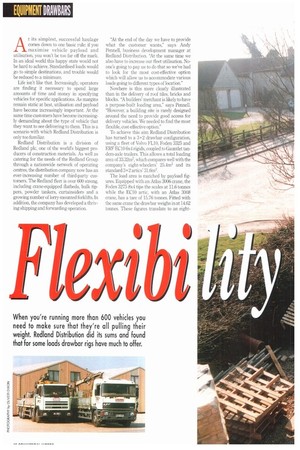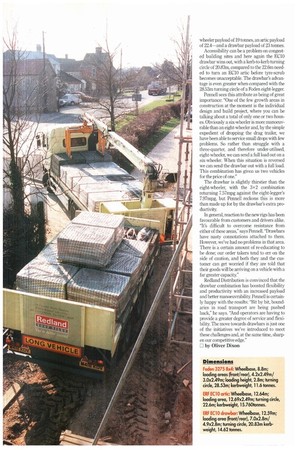When you're running more than 600 vehicles you need to
Page 62

Page 63

If you've noticed an error in this article please click here to report it so we can fix it.
make sure that they're all pulling their weight. Redland Distribution did its sums and found that for some loads drawbar rigs have much to offer.
At its simplest, successful haulage comes down to one basic rule: if you maximise vehicle payload and utilisation, you won't be too far off the mm-k. In an ideal world this happy state would not be hard to achieve. Standardised loads would go to simple destinations, and trouble would be reduced to a minimum.
Life isn't like that. Increasingly, operators are finding it necessary to spend large amounts of time and money in specifying vehicles for specific applications. As margins remain static at best, utilisation and payload have become increasingly important. At the same time customers have become increasingly demanding about the type of vehicle that they want to see delivering to them, This is a scenario with which Redland Distribution is only too familiar.
Redland Distribution is a division of Redland plc, one of the world's biggest producers of construction materials. As well as catering for the needs of the Redland Group through a nationwide network of operating centres, the distribution company now has an ever-increasing number of third-party customers. The Redland fleet is over 600 strong, including crane-equipped flatbeds, bulk tippers, powder tankers, curtainsiders and a growing number of lorry-mounted forklifts In addition, the company has developed a thriving shipping and forwarding operation. At the end of the day we have to provide what the customer wants," says Andy Pennell, business development manager at Redland Distribution. "At the same time we also have to increase our fleet utilisation. Noone's going to pay us to do that so we've had to look for the most cost-effective option which will allow us to accommodate various loads going to different types of location."
Nowhere is this more clearly illustrated than in the delivery of roof tiles, bricks and blocks. "A builders' merchant is likely to have a purpose-built loading area," says Pennell, "However, a building site is rarely designed around the need to provide good access for delivery vehicles. We needed to find the most flexible, cost-effective option."
To achieve this aim Redland Distribution has turned to a 3+2 drawbar configuration, using a fleet of Volvo FL10, Foden 3325 and ERF EC10 6x4 rigids, coupled to Gauntlet tandem-axle trailers. This allows a total loading area of 33.32m2, which compares well with the company's eight-wheelers' 25.4m2 and its standard 3+2 artics 31.6m2,
The load area is matched by payload figures. Equipped with an Atlas 3006 crane, the Foden 3275 8x4 tips the scales at 11.6 tonnes while the EC10 artic, with an Atlas 3008 crane, has a tare of 15.76 tonnes. Fitted with the same crane the drawbar weighs in at 14.62 tonnes. These figures translate to an eight wheeler payload of 19 tonnes, an artic payload of 22.4—and a drawbar payload of 23 tonnes.
Accessibility can be a problem on congested building sites and here again the EC10 drawbar wins out, with a kerb-to-kerb turning circle of 20.83m, compared to the 22.6m needed to turn an EC10 artic before tyre-scrub becomes unacceptable. The drawbar's advantage is even greater when compared with the 28.53m turning circle of a Foden eight-legger.
Pennell sees this attribute as being of great importance: "One of the few growth areas in construction at the moment is the individual design and build project, where you can be talking about a total of only one or two houses. Obviously a six-wheeler is more manoeuvrable than an eight-wheeler and, by the simple expedient of dropping the drag trailer, we have been able to service small drops with few problems. So rather than struggle with a three-quarter, and therefore under-utilised, eight-wheeler, we can send a full load out on a six-wheeler. When this situation is reversed we can send the drawbar out with a full load. This combination has given us two vehicles for the price of one."
The drawbar is slightly thirstier than the eight-wheeler, with the 3+2 combination returning 7.57mpg against the eight-legger's 7.97mpg, but Pennell reckons this is more than made up for by the drawbar's extra productivity.
In general, reaction to the new rigs has been favourable from customers and drivers alike. "It's difficult to overcome resistance from either of these areas," says Pennell. "Drawbars have nasty connotations attached to them. However, we've had no problems in that area. There is a certain amount of re-educating to be done; our order takers tend to err on the side of caution, and both they and the customer can get worried if they are told that their goods will be arriving on a vehicle with a far greater capacity."
Redland Distribution is convinced that the drawbar combination has boosted flexibility and productivity with an increased payload and better manoeuvrability. Pennell is certainly happy with the results: "Bit by bit, boundaries in road transport are being pushed back," he says. "And operators are having to provide a greater degree of service and flexibility. The move towards drawbars is just one of the initiatives we've introduced to meet these challenges and, at the same time, sharpen our competitive edge."
0 by Oliver Dixon Dimensions Foden 3275 8x4: Wheelbase, 8.8m; loading areas (front/rear), 4.2x2.49m/ 3.0x2.49m; loading height, 2.8m; turning circle, 28.53m; kerbweight, 11.6 tonnes.
ERF EC 10 artic: Wheelbase, 12.64m; loading area, I 2.69x2.49m; turning circle, 22.6m; kerbweight, 15.760tannes.
ERF EC I 0 drawbar: Wheelbase, 12.59m; loading area (front/rear), 7.0x2.8m/ 4.9x2.8m; turning circle, 20.83m kerbweight, 14.62 tonnes.






























































































































